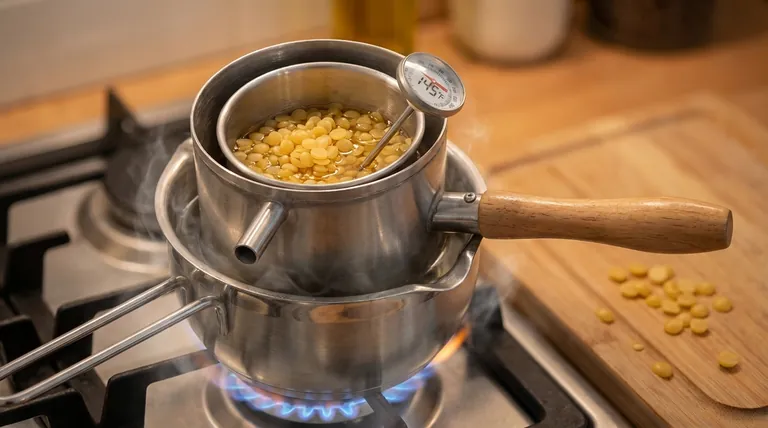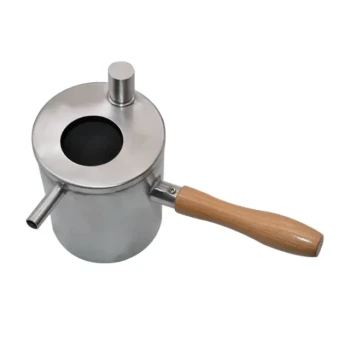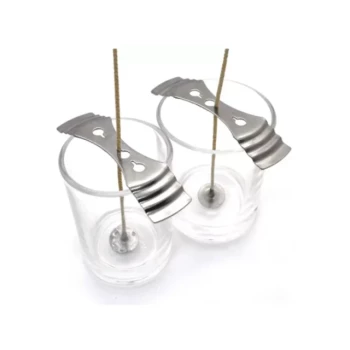For optimal quality and safety, beeswax should be melted at a temperature between 143°F and 151°F (61-66°C). It is critical to keep the temperature below 170°F (77°C) to prevent the wax from discoloring and losing its characteristic subtle aroma. Exceeding this temperature degrades the wax and introduces safety risks.
The core principle of melting beeswax is not just about reaching a specific temperature, but about applying gentle, indirect heat to control that temperature. This approach is essential for preserving the wax's natural qualities while ensuring a safe process.

Understanding the Critical Temperature Zones
Successfully melting beeswax requires understanding three key temperature thresholds. Each one has a direct impact on the quality of your final product and the safety of your workspace.
The Ideal Melting Range (143°F - 151°F / 61-66°C)
This is the target zone where beeswax transitions from a solid to a liquid. Within this gentle range, the wax melts efficiently without any damage to its color, scent, or beneficial properties.
Holding the temperature here ensures you get a clean, high-quality liquid wax perfect for any application, from candles to cosmetics.
The Quality Degradation Point (Above 170°F / 77°C)
Once you exceed this temperature, the delicate compounds in the beeswax begin to break down. This is not a subtle change; the wax will visibly darken and its pleasant, honey-like aroma will diminish or disappear entirely.
Some sources also note that heating above 175°F can destroy the wax's natural anti-microbial properties, reducing its effectiveness in products like balms or food wraps.
The Flashpoint Danger (Around 400°F / 204°C)
Beeswax is a flammable substance. If heated uncontrollably, especially over a direct flame, it can reach its flashpoint and ignite. This is the single most important reason why direct heat methods are strongly discouraged.
The Correct Method: Why Indirect Heat is Non-Negotiable
The key to staying within the ideal temperature range is to control the heat source. Direct heat, such as placing a pot on a stove burner, creates hot spots that will scorch the wax and create a significant fire hazard.
The Double Boiler Method
This is the most common and recommended technique. By placing a smaller pot with your beeswax inside a larger pot of simmering water, you use steam to provide gentle, even heat. This makes it nearly impossible to scorch the wax and gives you precise control.
Always ensure the water in the bottom pot does not boil away completely. A light simmer is all that is required.
The Crock-Pot (Slow Cooker) Method
For larger batches, a dedicated crock-pot is an excellent alternative. The low, consistent heat is perfect for melting wax over a longer period without the risk of overheating. This "set and forget" method is both safe and effective.
Common Pitfalls to Avoid
Even with the right method, simple mistakes can compromise your results. Being aware of these common pitfalls is crucial for success.
Rushing the Process
Patience is paramount. Attempting to melt beeswax quickly by turning up the heat is the most common cause of overheating. Allow the gentle heat to do its work slowly and evenly.
Neglecting to Supervise
Never leave melting wax unattended. It is a flammable material, and conditions can change quickly. A double boiler can run dry, or a thermostat can fail. Constant supervision is your primary safety tool.
Using the Wrong Equipment
Beeswax is notoriously difficult to clean from pots and utensils. It is highly advisable to use dedicated equipment solely for your wax-working projects to avoid contamination and hours of cleanup.
Making the Right Choice for Your Project
Your goal determines your focus. Use these guidelines to ensure you get the best results for your specific application.
- If your primary focus is preserving aroma and color (for cosmetics or candles): Stay strictly within the 143-151°F range and use a thermometer to ensure you never exceed 170°F.
- If your primary focus is safety and ease of use: Always use an indirect heating method like a double boiler or a dedicated crock-pot and never use direct heat.
- If your primary focus is melting large, clean batches: A large, dedicated crock-pot offers a safe and manageable way to melt wax with minimal hands-on time.
By approaching the task with an understanding of both temperature and technique, you can melt beeswax perfectly every time.
Summary Table:
| Temperature Range | Effect on Beeswax | Key Consideration |
|---|---|---|
| 143°F - 151°F (61-66°C) | Ideal Melting Point - Melts efficiently, preserves color, scent, and properties. | Target this range for optimal results. |
| Above 170°F (77°C) | Quality Degradation - Wax darkens, loses aroma and beneficial properties. | Critical threshold to avoid. |
| Around 400°F (204°C) | Flashpoint Danger - Wax can ignite, creating a serious fire hazard. | Never use direct heat to prevent this. |
Need reliable, high-quality equipment for your beekeeping operation?
Melting beeswax perfectly is just one part of a successful harvest. HONESTBEE supplies commercial apiaries and beekeeping equipment distributors with the durable, wholesale-focused supplies needed for efficiency and safety at scale. From wax melters to protective gear, we provide the tools for professional beekeepers to excel.
Contact our team today to discuss your equipment needs and discover how we can support your business.
Visual Guide

Related Products
- Professional Stainless Steel Wax Melter for Beekeeping and Crafts
- Beeswax Melter for Candle Making Honey Bee Wax Melter
- Steam Beeswax Melter Wax Warmer for Wax Processing
- Electric Flatting and Embossing Machine with Tray for Beekeeping
- 3D Square Honeycomb Pillar Silicone Candle Molds for Making Beeswax Candles
People Also Ask
- How do you pour melted beeswax into a mold? A Step-by-Step Guide for a Flawless Finish
- What are the steps for using a wax melter to melt beeswax? Master Safe, Efficient Beeswax Processing
- Can I melt beeswax in a wax melter? The Key to Safe, High-Quality Results
- How can you monitor the temperature of beeswax as it melts? Ensure Quality & Safety with Precise Control
- What are wax melters used for? Unlock Efficient Wax Processing for Your Business



















